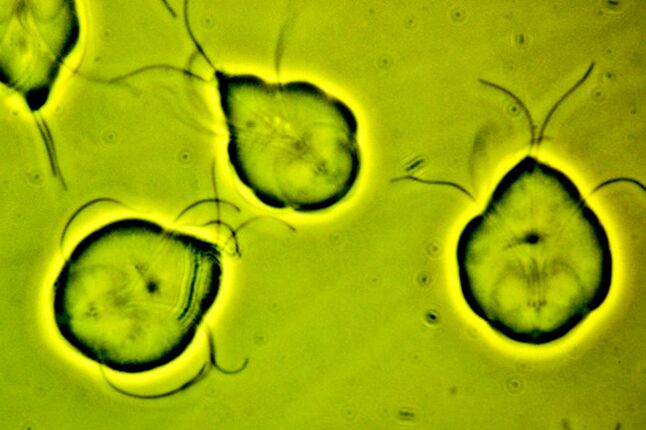When it comes to parasites in the body, most people think of worms in the intestines. However, other parasites are also common, which are difficult to diagnose and which affect other organs, not the intestines.
These are the simplest microscopic (mostly parasites) that may not appear for a long time. However, the simplest parasites can cause significant damage to the body.
Giardia
Giardia is a microscopic, flagellated parasite that has two nuclei and two groups of organelles.

Giardiasis in humans is caused by the most common type of parasite - intestinal lamellae. In addition to humans, other mammals and birds can also be infected with it. The parasite can form a cyst in the organ of localization.
Giardia is present in poorly treated tap water, as well as in natural springs - springs, wells. They can be found in the meat of an infected animal or bird, in small amounts in the stool of an infected animal, sometimes they survive in the soil, therefore they are present on vegetables and berries.
Usually the infection occurs by the fecal-oral route, that is, for the development of the invasion it is necessary to swallow a significant number of parasite cysts. As a rule, children from three months and adults are affected.
In most cases, the disease is asymptomatic and the patient learns about it by chance. But sometimes there is a symptomatology (constant or intermittent). Symptoms from the gastrointestinal tract are revealed:
- Stomach pain;
- Flatulence;
- Nausea, sometimes vomiting;
- Growling in the stomach;
- Constipation and diarrhea alternate;
- Biliary tract dyskinesia;
- Skin allergies;
- General weakness.
Like intracellular parasites, lamblia is mainly treated with metronidazole. However, at the first stage of therapy, it is necessary to get rid of poisoning and normalize the work of the bile ducts. Only then is anti-parasitic therapy prescribed. Thereafter, therapy is carried out aimed at restoring the body's defenses and increasing immunity.
amoeba
Amoebas are the simplest human parasites that cause amoebic dysentery, or amoebiasis.
There are also types of amoeba that can affect the eyes. Cause amoebic encephalitis, but are less common. The invasion is not the most common, only 10% of people have it according to WHO (while that number for giardiasis is 50, according to some sources).
Amoebas are only transmitted fecal-orally, which means, as in the previous case, amoeba form cysts that have to be swallowed so that an infection can develop.
In countries with hot climates and poor hygienic conditions, the likelihood of infection is higher. Cysts in soil, water, vegetables, and berries grown on contaminated soil can retain the ability to infect for long periods of time. Roaches and flies carry these cysts to some extent.
Like intracellular parasites, amoebas do not cause symptoms until 7-10 days after infection. Symptoms of colitis include: abdominal pain (in the lower part), general weakness, slight increase in body temperature. Most often, the liver is affected, as pain appears in it after two to three weeks, the organ grows and thickens.
Toxoplasma
Toxoplasmosis is a disease that causes Toxoplasma gondi. This is the simplest organism, mainly spread by representatives of the cat family, who are its carriers. An infected person is also able to spread it.
It is transmitted fecal-orally. You can get infected by eating poorly processed meat from infected animals and birds, as well as eggs. To a lesser extent, but still transferable via the blood, in the case of wounds (e. g. when working with contaminated soil in the garden) and in contact with mucous membranes.
It is usually asymptomatic and, like many viruses, is diagnosed by chance, for example during an enzyme-linked immunosorbent assay. In the acute form, healing often takes place independently. Pregnant women need treatment with pyrimethamine drugs (used to treat intracellular parasites).
Plasmodium
Plasmodia are intracellular parasites that cause malaria. Five types of pathogen can parasitize in humans. In addition, they are localized in the blood and are located on the membranes of its cells.
The disease is transmitted through blood (for example, through a transfusion). It is also tolerated by some species of mosquito when bitten, as the mosquitoes are the intermediate hosts of the Plasmodium. As a result, the person becomes infected with malaria.
These mosquitoes (and, accordingly, the disease) are widespread in hot countries, mainly in Africa.
Malaria has severe symptoms that manifest themselves 5-7 days after infection. The first symptoms are joint pain, fever, severe chills. Then headache, enlarged spleen.

Treatment with quinine preparations is carried out strictly under medical supervision.
Trichomonads
These are the simplest human parasites that cause trichomoniasis. Affects the human genitourinary system. It is the most common sexually transmitted disease and also the most common disease of the genitourinary system.
Transmitted through sexual contact only. In women, they live in the vagina, Trichomonas in men - in the urethra, seminal vesicles, prostate.
In women, the symptoms are as follows: discharge, itching and redness of the skin of the genitals, painful urination and sexual intercourse, inflammation of the vaginal mucosa. In men: discharge from the urethra (rarely with blood), painful urination, symptoms of prostatitis with damage to the prostate.

It is necessary to treat the disease in both partners. It is treated with anti-Trichomonas drugs strictly individually and under medical supervision. In some cases, immune or symptomatic therapy is required.
























